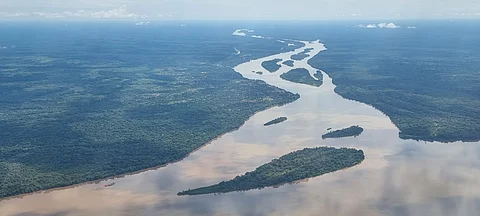

The World Bank has approved $250 million in financing for the Inga 3 hydropower project in the Democratic Republic of Congo (DRC), marking a dramatic re-entry into large-scale dam funding despite widespread opposition from civil society groups and longstanding governance concerns.
The Inga 3 project, which could eventually receive up to $1 billion in funding, is part of a larger $10 billion hydroelectric scheme on the Congo River. Its backers claim it will alleviate the DRC’s severe electricity deficit, with only about 20 per cent of the population currently having access to power. But the scheme is more likely to benefit industrial users and foreign offtakers than ordinary Congolese, stated a press note from human rights organisation International Rivers on June 3, 2025.
“This approval is a misguided effort by the World Bank to promote hydropower in the DRC after many years and millions of dollars have been spent with nothing to show for it,” Apollinaire Nsimbi of Initiative pour le Développement Local (IDEL) said in the statement, echoing deep scepticism from groups that have tracked the project for over a decade.
The Inga 3 dam would be the third major dam on the lower Congo River, following Inga 1 and 2 — projects that left behind a legacy of displacement, environmental degradation and unmet promises of development. According to affected communities, more than 30,000 people could be displaced by the new reservoir, many of them already uprooted by the earlier dams and still awaiting compensation.
“My family lost everything as they were among those physically and economically displaced by Inga 1 and 2, and we are not prepared to again sacrifice our land and livelihood for the construction of Inga 3,” said Angelique Mvuezolo, director of Femmes du Fleuve, an organisation representing women from riverine communities.
The Bank originally backed Inga 3 in 2014 but pulled out amid governance concerns. Its renewed support comes as it resumes funding for large dams after a decade-long hiatus, a shift that advocacy groups say contradicts the global climate finance agenda.
“Mega dams are not climate solutions—they are climate liabilities,” said Genny Ngende of International Rivers, citing the risk of methane emissions from reservoirs and the growing vulnerability of large dams to extreme weather events. “It is long past time for the World Bank to promote mega dams like Inga as a silver bullet to address Africa’s energy needs. The future of African energy must be decided by and for its people, not investors and corporations.”
Groups also warned that Inga 3 could saddle the DRC with unsustainable debt. The planned public-private partnership model may incentivise investors to prioritise profit over public access, channelling electricity to mining companies and regional export markets rather than domestic consumers.
“Inga 3 threatens to deepen the DRC’s debt burden without delivering promised energy access to the millions of Congolese who need it,” said Emmanuel Musuyu, executive secretary of the civil society coalition CORAP.
The project has drawn particular ire for its opaque consultation process, which civil society leaders say has systematically excluded dissenting voices. Communities have reported declining fish stocks and prolonged food insecurity since being forced off their lands for earlier dams, yet their concerns appear to have been downplayed in official assessments.
Siziwe Mota of International Rivers condemned the Bank’s decision as a return to “top-down mega dams that threaten communities and ecosystems”, urging investment in decentralised renewable energy alternatives instead.